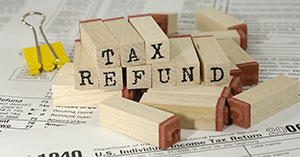Lessons learned from tax season: 7 steps for a happier 2019
 by Benjamin R. Bostic, CPA
by Benjamin R. Bostic, CPA
There It’s a moment of eager anticipation – getting that tax refund. Many families this year, however, were shocked by smaller-than-expected refunds or even the prospect of owing money.
If tax reform was supposed to lower my taxes, they wondered, why is my refund smaller?
Every situation differs, but overall the Tax Cuts and Jobs Act of 2017 (TCJA) reduced taxes by an average of about 25 percent, or $1,200. Also, most individuals saw an increased paycheck as a result of reduced withholdings.
But here’s the rub: To accommodate for TCJA, the IRS updated its computations for determining adequate withholdings. Unfortunately, 80 percent of Americans didn’t update their Form W-4 to reflect these revisions.
Other TCJA provisions shocked such taxpayers as workers accustomed to deducting large unreimbursed employee expenses, and those living on investment income. High-income taxpayers and those living in highly taxed states certainly felt the pinch of the state and local tax limitation.
Now that we’ve been through a round of post-tax reform filings, it’s time to consider lessons learned and take steps to prevent those unpleasant surprises next year.
7 tax changes to make now
1. Update Form W-4.
The process can induce headaches, but it’s essential to match withholdings with your tax liability. Even if you were satisfied with the 2018 outcome, make sure your W-4 is up to date, because the IRS published its new computations two months into the tax year, and 2019 withholdings will be calculated for the full 12 months. Failure to revise your Form W-4 can mean withholdings don’t match actual tax liability, or they fall short of anticipated refunds.
2. Rethink your refund.
What you call a tax refund is actually an interest-free loan to the U.S. government. The feds hold your money, month after month, and finally return any excess in the form of a tax refund. Why not calculate withholdings close to the amount owed, and then put the extra dollars into savings vehicles that earn interest for you and your family?
3. Direct your Required Minimum Distribution (RMD) to charity.
The new, higher standard deduction ($12,000 for single filers, $24,000 for married filing jointly) makes it hard to claim deductions for charitable gifts. However, retirees have a possible solution. Consider donating a portion of your required minimum distribution (RMD) from retirement funds directly to charity. RMDs are taxable, but these qualified charitable distributions, as they’re known, are not.
4. Group your charity and health expenses.
Taxpayers are learning to bundle donations that might have been made in separate years – for instance, combining two annual $10,000 donations into a single-year, a $20,000 gift. The same principle can apply to health care expenses. Reaching the 7.5 percent of income threshold needed to deduct health expenses can be difficult, but if your household anticipates major procedures and the related high out-of-pocket costs, try to schedule them in a single tax year.
5. Renegotiate income.
Ask the boss for a pay cut? In some circumstances, it’s not as crazy as it sounds. For example, the salesperson making $100,000 a year might also have $10,000 in unreimbursed employee expenses. By negotiating the salary to $90,000 plus $10,000 in reimbursed expenses, the employee pays taxes only on the salary, while both the employer and employee save on employment taxes.
6. Business owners: Maximize QBI deduction.
This one requires a deep dive with a CPA, but most business owners qualify for the new, 20 percent qualified business income (QBI) deduction. Eligibility depends on such criteria as taxable income, type of business, amount of W-2 wages paid, and the unadjusted basis in qualifying property held by the business.
7. Investment alert.
Some people living on investment income also pay significant investment fees, but those fees are no longer deductible. At portfolio review time, it’s worthwhile to plan for a higher tax bill.
Change is hard, especially when it involves something as complex as the American tax code. Remember that even a thinner tax refund didn’t necessarily mean you were worse off. We made it through the first round of post-TCJA tax filings, and the professionals of Boyer & Ritter are ready to help you prepare for smooth sailing in tax years to come.
Keep an eye out for Ben’s upcoming article which gives a deep dive into the QBI Deduction.
Benjamin R. Bostic, CPA, is a manager at Boyer & Ritter with experience providing tax and accounting services for individuals, not-for-profit, and closely held business clients. Reach Ben at 717-264-7456 or bbostic@cpabr.com



